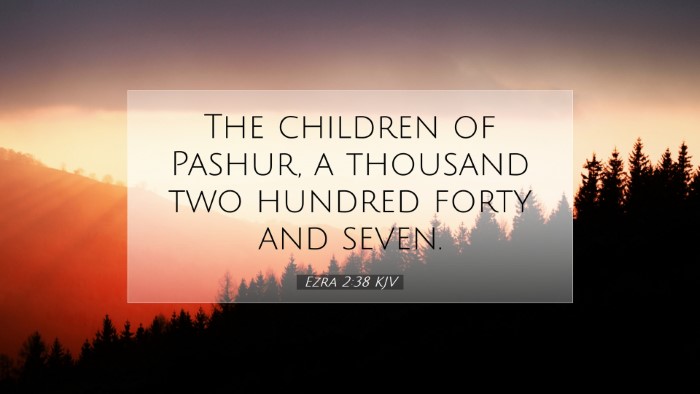Commentary on Ezra 2:38
Ezra 2:38 states:
"The priests: the children of Jedaiah, of the house of Jeshua, nine hundred seventy and three." (Ezra 2:38, KJV)
This verse lists the priests who returned from the Babylonian exile, specifically identifying the descendants of Jedaiah, a key figure in the history of the Jewish priesthood. The count here indicates the organizational structure and the significance placed on priestly lineage during the restoration period.
Overview of the Context
The book of Ezra centers on the return of the Jewish exiles to Jerusalem and the rebuilding of the temple after the Babylonian captivity. This particular chapter, Ezra 2, is essential as it provides a register of those who returned, emphasizing God’s faithfulness in fulfilling His promises to restore His people.
Insights from Public Domain Commentaries
Matthew Henry's Commentary
Matthew Henry offers a significant observation regarding the returning priests. He emphasizes the spiritual leadership they represent within the community. The listing of their names and numbers serves to highlight the importance of the priestly line in Israel’s restoration.
- Accountability of the Priests: Henry notes that the presence of priests like Jedaiah's descendants reflects God’s ongoing covenant with Israel, stressing that the priesthood was to carry the responsibility of worship and maintain the sacrificial system.
- Number and Significance: The specific number, 973, indicated by Henry, alludes to the precise and ordered manner in which God preserves His people. Each individual plays a role in fulfilling God's purpose for the nation.
Albert Barnes' Commentary
Albert Barnes adds depth to the historical significance of this return. In his commentary, he discusses the legacy that these priests carried back to Jerusalem.
- Historical Reclamation: Barnes highlights how the returning priests signify the restoration of the religious order that had been displaced during the exile. The number 973 emphasizes the priestly authority re-established among the people.
- Lessons for Contemporary Readers: Barnes encourages present-day believers to view this return as a model of spiritual renewal and restoration, emphasizing the continuity of faith from the past into the present and future.
Adam Clarke's Commentary
Adam Clarke provides further context and interpretation regarding the familial lineage of the priests of Jedaiah.
- Priestly Lineage: Clarke notes that Jedaiah was a descendent of the high priest Eliashib. This lineage is crucial as it connects the returning priests to a long-standing tradition of worship and service within God's temple.
- Symbol of Hope: For Clarke, the return of such a significant number of priests is a symbol of hope and regeneration for the nation of Israel, showing God's direct involvement in restoring his people to their rightful place in His plan.
Theological Implications
The return of the priests as recorded in Ezra 2:38 thus carries substantial theological implications:
- Covenant Continuity: The listing underlines the continuity of God’s covenant with Israel, demonstrating that despite exile and tribulation, God preserves a remnant to maintain the integrity of worship.
- Restoration and Renewal: This event signifies a time of restoration where worship practices could resume, allowing for a renewed relationship between God and His people.
- Community Identity: The focus on these priests reaffirms the community’s identity as a people called out for God, reinforcing the importance of faithful leadership in guiding the actions of God’s people.
Personal Application
For pastors and theologians, this verse and its accompanying commentary can provoke reflection on leadership and spiritual heritage within modern communities:
- Leadership Roles: It calls for a thoughtful examination of the role of spiritual leaders in contemporary congregations and how their heritage influences current practices and faithfulness.
- Faithfulness in History: It serves as a reminder of the faithfulness of God through generations, inspiring leaders to cultivate a deeper understanding of their own historical and spiritual roots.
- Commitment to Restoration: The priests returning to Jerusalem illustrates the commitment required to engage in the work of restoration, both personally and in the broader church context.
Conclusion
In summary, Ezra 2:38 is not merely a historical record but a profound reminder of God’s providential care through the generations. The return of the priests marks not only a physical return to Jerusalem but enriches the spiritual fabric of the community. For individuals today, whether pastors or scholars, the verse encourages a deeper appreciation for migration, restoration, and the significance of continued faithfulness to God's calling in a changing world.


